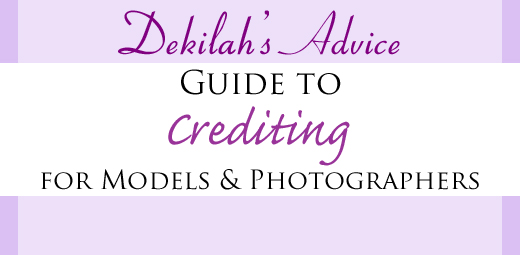Over the past few weeks I’ve seen a lot of talk about crediting others you work with as a model or photographer (or MUA, body painter, stylist, etc). While this seems cut and dry to some of us, there are actually a few different thoughts on this, at least in specific cases. I’ll outline my insight as well as some of these specific cases for you and I’d love for you to share your thoughts in the comments after you read, too.
First, let’s talk about what crediting is: basically, a credit is listing the name or names of the other people who worked on the creation of the photo. Here is an example for you:

This is a standard example. In this case there were only two of us involved. I did my own makeup and styling, and I chose not to credit myself for that because it’s pretty standard stuff. Had there been an MUA or stylist, I would have credited them as well.
Now that we’ve established what a credit is, let’s jump in to some of the ins and outs and specifics.
Why Should You Credit Those You Work With
Many models and photographers are freelancers and/or small businesses. Part of the way our name and face gets out there is via credits on images we were part of creating. This is especially true when we shoot trade and portfolio work. In my opinion, part of the compensation for a trade shoot is the potential exposure and opportunities for future work in addition to the resulting photos.
Another reason, though I really think the first is the most important, is that crediting is often expected and if others see that you don’t credit, they may be less likely to work with you. I know many models and photographers who will at least not contact someone whose work they may like if they notice that person does not credit those they work with.
What Name Should You Use to Credit Someone
This is probably #1 thing that tends to vex photographers, but it’s relevant to models too. Many of us do use a model or photography name and some people, often photographers who shoot families or commercial work as well as artistic and art nude work, may have more than one name. If you’re approaching this for this first time, I can certainly understand how you might be confused.
The best piece of advice I can offer you is this: just ask. I usually do this when I receive photos and I also make a note of how I’d like to be credited on the release when I sign it. I’ll just add something like “Please credit as Dekilah” in the margin. I also often mention how to credit me after we’ve booked or confirmed the shoot.
What About Tagging on Facebook
Most, or at least many, models and photographers use Facebook to share their work with others. Facebook allows you to link the person’s name with the photos you are sharing of them. This can be a bit of a problem as some of us are thrilled to be tagged and actually prefer it while others don’t want the images linked to their profile due to family or work concerns. I suggest asking before tagging because the photos will possibly show up on the person’s profile and be linked to their personal photos.
And yes, sometimes Facebook auto tags. In that case, the other person has their Facebook settings set so that this happens, so I wouldn’t worry about it too much. If you want to check your own settings on this, go here and check on the setting on tagging photos.
Also, understand that just because someone doesn’t want you tagging, does not mean they do not want to be credited by their model or photography name. While tagging is a form of crediting, it’s not the only way to credit one, even on Facebook.
What To Do If You’re Asked Not to Credit
Sometimes we do work that we do just to try something or to walk a line of our comfort levels as an experiment and maybe we are okay with the other person sharing the photos, but we don’t want to be credited. In these cases, I suggest listing the person asking not be credited as “Anonymous.” Or you can say something like “Photographer has been asked to remain uncredited.” I suggest doing this versus simply not giving any information as it shows that you are doing you part, not just hiding the person’s name or forgetting, and that they have chosen to remain unnamed.
How to Keep Track
We’re all people and we can all be a little bit different. So how can you keep track of it all? My personal method is this: I use my folder names. I have a folder for each photographer (organized by year) and I list them by the name to credit, the month and year, and then the person’s real name. So I might have a folder named “Pretty Pictures Photography – Aug 2015 – Polly Prescott” (all of that was made up, not someone I’ve actually worked with).
Photographers, I suggest that you include a blank on your release for the model’s name to credit by if you can. You can even scan the release in and save it to the folder you keep those photos in.
If you found this article helpful, please share it and consider supporting this blog via PayPal (you can choose any amount).




